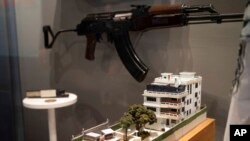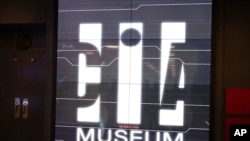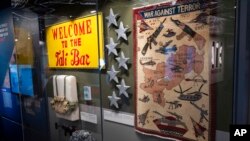The CIA on Saturday revealed the model of a safe house used to brief President Joe Biden about the whereabouts of al-Qaida leader Ayman al-Zawahiri before it killed him in a drone strike in Afghanistan.
Shortly after al-Zawahiri's death, White House officials released a photo showing Biden talking to CIA Director William Burns with a closed wooden box on the table in front of them. Now, the contents of the box — a model depicting a white-walled home with at least five stories and three partially obscured balconies — are on display at the CIA Museum inside the agency's Virginia headquarters.
The museum is closed to the public and access is generally limited to the agency's employees and guests. The CIA allowed journalists to tour the museum, newly refurbished in time for the agency's 75th anniversary, as part of a broader effort to showcase its history and achievements.
Most of the exhibits took years or decades to declassify. The al-Zawahiri model home is the rare artifact that had been used by intelligence officers just weeks beforehand.
Al-Zawahiri was killed in late July, nearly a year after the U.S. withdrawal from Afghanistan ending a two-decade war in which the CIA had a central role. The agency sent the first American forces two weeks after the Sept. 11, 2001, terrorist attacks. Two decades later, it pulled out intelligence assets and assisted in the chaotic evacuation of thousands of Americans and Afghan allies.
The Biden administration has said the strike shows it retains what it calls an "over-the-horizon" counterterrorism capacity in Afghanistan. Opponents of the administration and some analysts question whether al-Zawahiri's presence in a Kabul neighborhood suggests extremist groups like al-Qaida or the Islamic State are growing stronger under the Taliban, who now rule the country.
The strike was particularly meaningful for the CIA, which lost seven employees in trying to find al-Zawahiri, a key plotter of the Sept. 11 attacks who was then al-Qaida's second-in-command.
They were killed when a Jordanian doctor who pretended to have information about al-Zawahiri carried out a 2009 suicide bombing at a base in the Khost province in Afghanistan. The doctor was working for al-Qaida.
On display near the model of al-Zawahiri's home are seven stars honoring the CIA employees slain in the Khost province. The stars were previously part of a memorial in Afghanistan that was taken down as the U.S. withdrew.
Other newly revealed artifacts include concept drawings for the fake film created as part of a 1980 operation to rescue American diplomats from Iran, the subject of the 2012 movie Argo starring Ben Affleck. There are also crew uniforms and other items from the Glomar Explorer, the Howard Hughes-built ship that served as cover for a 1970s mission to surface a sunken Soviet submarine carrying nuclear-armed ballistic missiles. (The story on the front page of the Los Angeles Times exposing the operation is reproduced on a nearby museum wall.)
The museum also includes some information on the agency's darker moments, including its role in the ultimately false assertions that Iraq had weapons of mass destruction before the 2003 U.S. invasion, as well as the exposure and execution of several key spies the U.S. had in the Soviet Union.
Janelle Neises, the museum's deputy director, says a running agency joke about the collection is that for most people, it's "the greatest museum you'll never see."
The CIA wants to use its history to engage more with the public, albeit on the narrow terms one might expect of an intelligence service. The number of annual visitors to the museum, for example, is classified. Among the known guests are U.S. lawmakers, officers from other law enforcement and intelligence agencies, and foreign officials.
But CIA employees posted about some of the museum's roughly 600 exhibits on social media. The agency also recently started a podcast with Burns, the CIA director, as its first guest.
A primary goal of the museum is to reinforce lessons from the agency's successes and failures for the current workforce, Neises said. Some CIA veterans who served in the missions depicted in the museum donated artifacts to the collection. But the agency is now hiring officers in their 20s who are too young to remember the Sept. 11, 2001, attacks.
"The idea here is as you're going to lunch or as you're going to a meeting, leave 10 minutes early, leave 20 minutes early, and just take the time to look at one section and really learn about your history," Neises said.











